1/1/2021
Training Your Team to Water Properly
Bill Calkins
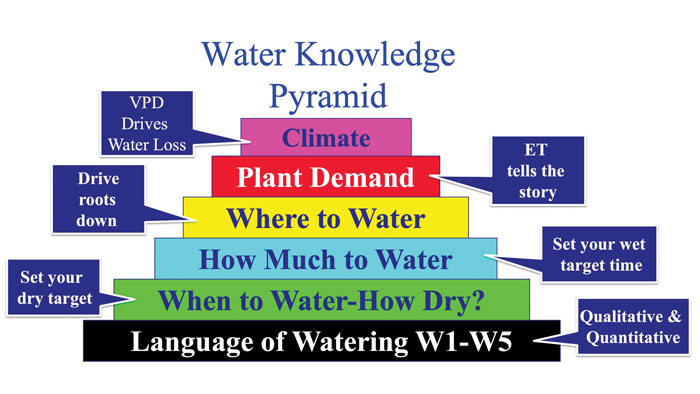
The importance of watering cannot be overstated. It’s one of the fundamentals of greenhouse production and something that involves just about every member of your team, from the office to the greenhouse floor.
Pictured: This water knowledge pyramid is your cheat sheet to watering success.
Ball Horticultural Company’s Senior Technical Manager Dr. Will Healy has been on a mission to help educate growers about the importance of watering for many years, but most recently has presented a plan to greenhouse professionals at industry conferences, video training and in podcasts. His mantra is: “Fish grow in water; roots grow in air.” This means that a grower’s job is NOT to water. Read that again—NOT to water. The most important thing to remember is a grower’s job is to dry the soil to the correct moisture level because this is where healthy growth begins.
He takes it a step further by suggesting that owners shouldn’t pay production teams to water, but rather pay them when the soil hits the established dry target. Obviously, he’s being facetious, but you get the point.
The language of watering
It’s critical to approach watering from both qualitative and quantitative strategies. Qualitative is the easy one and you’ve most likely been doing this for years. It’s the opinion-based approach. You look at a crop or perhaps pick up a few pots and decide if it’s time to turn on the hose or boom. You may even know what the soil should look like when at an optimal water level for healthy growth. The question is do all members of your team have the same opinions? Doubtful.
The second method is quantitative and takes data into account. More and more growers are weighing trays, pots and baskets to determine exact weights that correspond to water levels. Both approaches can work and work well—as long as everyone is speaking the same language.
Will and his team have developed a visual and tactile way to determine when plants are wet or dry, and have created levels to help educate growers:
Level 5: Saturated soil, resulting in water freely dripping from the soil
Level 4: Saturated with water easily squeezed out
Level 3: Will drip if squeezed tightly
Level 2: On the dry side with the plant just starting to wilt
Level 1: Dry as a bone with soil blowing off and plants completely wilted
Each of these levels has a result in production, positive or negative. Your goal is to water to a level 4 and then let the crop dry down to a level 2 before applying water again.
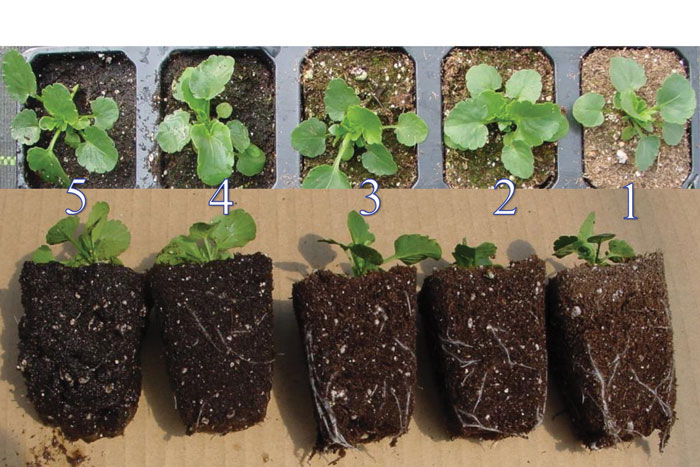
Pictured: Be sure your entire production team is aligned on these water levels.
Watering by weight is an effective strategy used by growers who want extra attention to detail and the ability to use hard data to make decisions. It requires recording and plotting daily container weights (more attention), and takes into account daily water use and (even more importantly) night losses. The weight of pots or trays is recorded before and after watering, and the subsequent loss is also recorded since the last watering, giving growers insight into how quickly crops are drying down. The only tool required is a kitchen scale that measures grams.
As you record and plot the data, you’ll quickly be able to determine your best watering strategy and share this information across your production team. The impact of as little as 100 grams of water in a plug tray is dramatic and can be the difference between a saleable tray and a dumped tray.
Where to water
Will makes the point that the soil in which roots grow is three-dimensional space and must be considered as such. There’s an edge (by the sides of the pot or cell), the middle, and the depth or bottom. Water must permeate all areas to be effective in developing a vigorous root system. This also relates to the levels mentioned above. Rotating between levels 2 and 3 throughout the soil mass results in a highly branched root system, i.e., optimal crops, whereas level 5 at the top and 2 at the bottom creates horizontal roots at the top, which isn’t at all what you want. Watering to a level 4 is sufficient to permeate the soil column and achieve some drip out of the pot or tray.
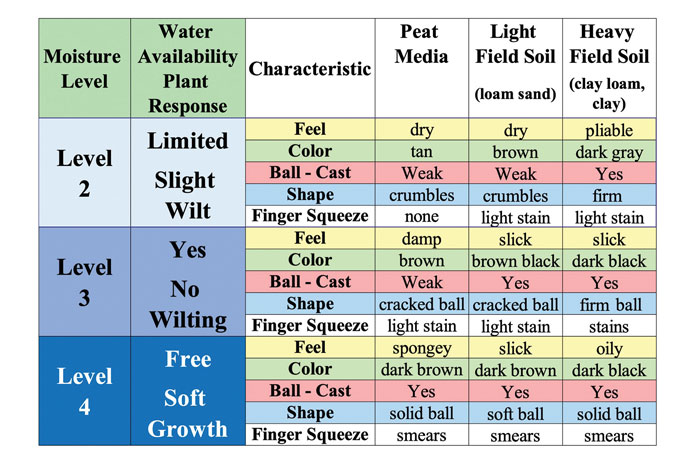 Pictured: Water levels involve multiple senses. Conduct hands-on training for best results.
Pictured: Water levels involve multiple senses. Conduct hands-on training for best results.
Growers who are especially heavy with the hose might end up with pots that are a level 4 at the top and 5 at the bottom, which results in water roots that aren’t healthy and are especially susceptible to disease, leading to many problems, including plant loss. Similarly, watering to a level 3 at the top and 5 at the bottom creates vertical roots and equally bad results in terms of plant loss and problems that you’ll have to go back and solve. Fixing problems caused by poor watering can not only be challenging, but also very costly.
One way to maximize your potential for success is choosing your tools carefully. There are many types of hose and boom nozzles to choose from and knowing how much water to apply to achieve the desired water level is critical when selecting them.
Does everyone on your team water at the same speed or pace? Doubtful. The volume of water and speed of application has clear impacts on how much water is in different parts of the pot or tray. Take some time to review nozzle selection and watering speed with your production team to get everyone on the same page. Do this as often as possible to build consistency.
Will reminds growers who germinate seeds, watering starts with your watering tunnel. Uniform watering is imperative, and this comes down to pressure and gallons per minute per nozzle and the number of nozzles used. How much do you know about your nozzles? Maybe it’s time to look at them again.
More on the process
According to Will, drying out of cells or pots is due to evaporation of the water from soil. This can be calculated when watering by weight. He also explains that water loss is sigmoidal over time. That’s a weird word that basically means when water loss is graphed, it creates an “S” shape. To put it into greenhouse terms, water loss is slowest at levels 5 and 1 and much more even at levels 4 to 2. Healthy plants grow when the graph is linear.
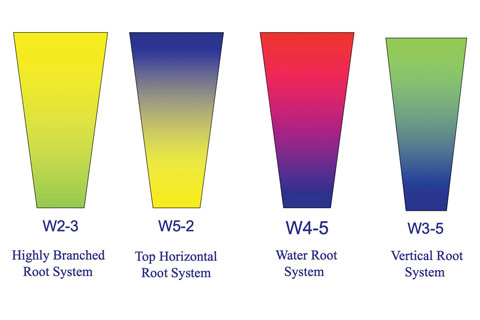
Pictured: Water application has dramatic effects on root growth. Here’s a visual way to see the benefits of following strict protocols.
We already learned that the most water is lost from evaporation, but transpiration also drives water loss. Consider the acronym “ET”—evaporation and transpiration. When you weigh trays or pots, the change in weight will predict the ET rate. Once you start collecting data, you’ll observe the trends. This means you must weigh the same containers in the afternoon (after your greenhouse is put to bed for the night) and again in the morning (before watering). If, for instance, you lose 200-plus grams of water overnight, Will says this is quite rapid ET. If you lose 100 to 200 grams, your crops are in an ideal cycle. At 50 to 100 grams lost overnight, the crops are too wet. And if they lose less than 50 grams, you’re running the risk of tip abortion. He suggests tracking Night ET (afternoon/morning) and Day ET (morning/afternoon) for the most useful data.
Watering success
Will always reminds growers that whatever method you use, qualitative or quantitative, be sure your teams speak the same language when it comes to watering. Communicate your approach and remind growers often. Consistency is key. Be sure to set wet and dry targets, and stick with them. Over time, they’ll become ingrained.
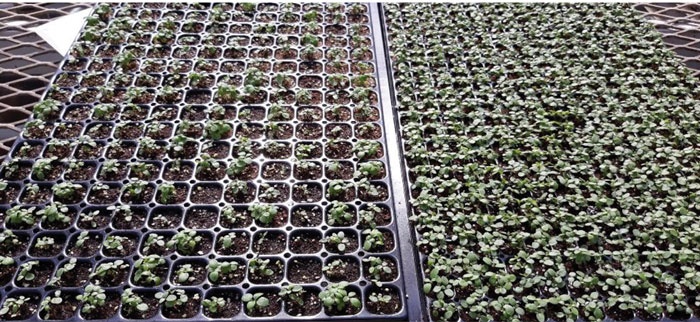 Pictured: A 100-gram water difference may seem insignificant, but it can make or break a crop
Pictured: A 100-gram water difference may seem insignificant, but it can make or break a crop
When watering, drive the roots down using appropriate methods and tools. Examine root systems to make sure this is happening. Consider the stage of the plants and adjust accordingly, and remember that VPD (vapor pressure deficit) drives water loss, underlining the importance of your greenhouse climate when setting targets and measuring success.
The best irrigation methods help to draw roots to the bottom of a container. Your goal is to saturate to a level 4 (where water is starting to drip from the bottom of a pot or cell) and then dry to a level 2. If you can train your team to water in this 4-to-2 pattern using visual (qualitative) methods or data-driven (quantitative) methods, you’re on the path to success. Remember, it’s the drying that improves rooting. GT
For more on watering from Dr. Will Healy, check out Ball Tech On Demand at growertalks.com/TechOnDemand.